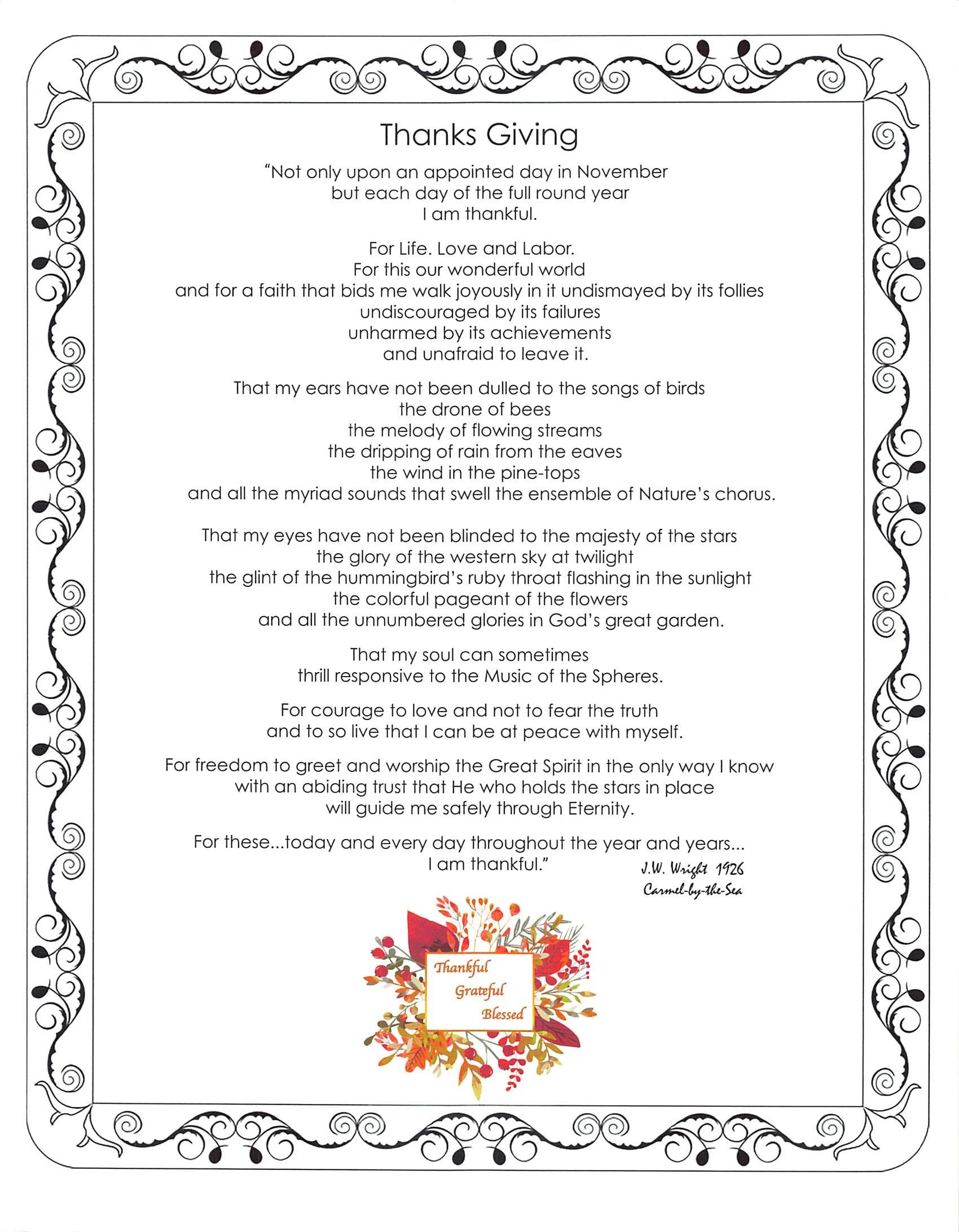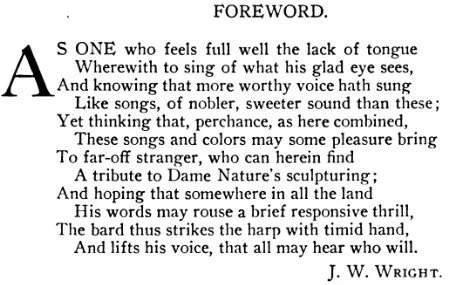Thanks Giving
Introduction
As we approach Thanksgiving, I was reminded of an excerpt from a beautiful poem we included in my mother’s obituary over 5 years ago. The poem is titled “Thanks Giving” written in 1926 by J. W. Wright (1871-1950), a little known poet and author, who after retiring as a newspaperman moved to Carmel-by-the-Sea and lived there for about 10 years. While in Carmel he set up a small printing press, known as the “Press in the Forest”, and became part of its Bohemian and artistic community. Wright’s private press produced a number of modest books in which he set the type by hand, printed, and hand-bound the books by himself, often in limited editions all made with great care.
Included in this post is the complete poem, “Thanks Giving”, and a biography of J. W. Wright I found in in July 2020 edition of the Carmel Pine Cone. May this poem instill within you a heart of gratitude in this Thanksgiving season and in each of our remaining days.
“Give thanks to the Lord, because he is good. His faithful love continues forever.”
J. W. Wright Biography by Neal Hotelling
From the Carmel Pine Cone from June 5-11, 2020 Edition
Jacob William Wright, “Willie,” was born in 1871 in Chicago, but his parents soon divorced and his mother ended up raising him in Watertown, Wis., with her parents. His grandparents, Jacob and Mary Van Alstyne, were also a strong influence until they died within months of each other when Wright was about 16. Wright’s mother encouraged his art and music studies, and after graduating from Watertown High School in 1888 he attended Wisconsin’s Beloit College.
Wright’s mother remarried in 1889 and moved to Chadron, Neb. Wright graduated from Beloit College in 1893. He was a member of Alpha Zeta chapter of the Sigma Chi fraternity and served as leader of the college orchestra, sang bass in the glee club, played guitar in the banjo club, and was active in the Delian Society for literature and oration.
After graduation, Wright joined his mother in Nebraska where he launched the Dawes County Journal, later called the Chadron Journal. In 1897, he moved and became editor and business manager of the weekly edition of the Colorado Springs Gazette. He also wrote for its daily edition. In 1899, Wright’s poetry appeared in a remarkable book, Colorado in Color and Song, published by Frank Thayer. It featured 25 half-tone color prints, with verse from Colorado writers.
His mother and her husband joined Wright in Colorado about 1900, and Wright branched into other avenues of commerce. In 1901 he was elected secretary treasurer of the Gold Hill Gold Mining Co., and in 1902, he became secretary of the newly formed Colorado Springs real estate exchange.
After his stepfather died, Wright moved his mother in 1903 to the Los Angeles area; however, he was soon back in Colorado Springs, where he became known as a prominent dealer in bonds, stocks and mines. He made annual visits to his mother and in 1907 was joined on them by his new wife, Roselpha Green. In 1912, the couple moved to Pasadena to be closer to his mother.
There he formed J.W. Wright & Co. and became a prosperous realtor. With success came nostalgia, and at 45, Wright self-published his first book, “The Long Ago” (1916), a remembrance of the simpler days of his youth, showing a clear appreciation of his grandparents. The first two printings were under his own name. A third printing, still bearing the 1916 copyright, was published by B. Hopkins, New York. In 1919, Vroman’s, a large book dealer in Pasadena, published a book of Wright’s verse, “The Glad World.”
All the while, Wright continued with his growing real estate company. In 1920, he took on Ellis Bishop as a named partner, becoming Wright, Bishop & Co. They hired Ethel Shockley as a secretary. The striking 24-year-old Kentucky native had come west with her family about 10 years earlier. She became quite significant to Wright.
The next year, Wright published a new edition of “The Long Ago,” this time as The Van Alstyne Co., using his grandparents’ name. He and Bishop split after just a year, and were tiring of the business grind. The death of Wright’s mother in 1924 was a catalyst for change. Wright acquired a hand letter press and moved to Carmel — with Shockley coming along. Wright bought a lot on Mountain View and built a stone-and-redwood home with a large living room. At one end of the living room, he set up the press and the couple went into the slower paced business of “The Press in the Forest”.
The first of his books they produced was “No Gifts,” including two short Christmas stories, as well as his story of The Press, which he described as “not merely a building & machinery. It is a guild wherein you have your part.” The craftsman can create the book, he explained, but the readers take the book into their lives.
In the first two years, they published at least 10 small books, all penned by Wright, printed on imported, high-quality papers and hand bound. Many were limited editions.
Soon they were printing books for a few other authors, too. In 1928, he printed a commemorative booklet for the opening of the El Paseo building at Dolores and Seventh. In 1929, he printed a booklet about Carmel for realtor Elizabeth McClung White.
Wright and Shockley married in February 1930. After a few more years of printing fine books and other ephemera, The Wrights decided to travel. In 1935, they turned the house and business over to Irving Gunderson for their two-year absence.
There is no comprehensive list of the publications of The Press in the Forest. Working with Stanek and reviewing other sources, we’ve compiled a list of more than 25 known publications from The Press in the Forest, but only one dated after 1932 — a new, hardbound edition of “The Glad World,” published in 1942 and limited to 305 copies.
In 1944, the Wrights sold the press and their home and moved to the desert, near Twentynine Palms. J.W. Wright died there in 1950, Catherine in 1962.


